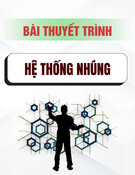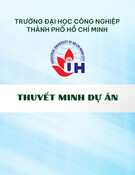
50 Journal of Mining and Earth Sciences, Vol 66, Issue 2 (2025) 50 - 64
Model-free recursion-based control for 5-degree-of-
freedom under-actuated Autonomous Underwater
Vehicles via online-tranining neural network
Tung Thanh Sy Ngo 1, Dung Manh Do 2,*, Hai Xuan Le 3, Khoat Duc Nguyen 1
1 Hanoi University of Mining and Geology, Hanoi, Vietnam
2 Hanoi University of Science and Technology, Hanoi, Vietnam
3 Hanoi National University, Hanoi, Vietnam
ARTICLE INFO
ABSTRACT
Article history:
Received 28th Nov. 2024
Revised 10th Mar. 2025
Accepted 23rd Mar. 2025
The ability to operate in underwater conditions autonomously without
human intervention is one of the most intrigued salient features of
Autonomous Underwater Vehicles (AUVs), directly leading to profound
attention from the scientific community in recent years. However, the
scientific research focusing on improving the AUVs’ operation is challenged
due to the lack of actuators, unknown dynamics, uncertain parameters and
strong nonlinearities. To overcome the technical restriction caused by the
actuator shortfall, this paper introduces a new control strategy for under-
actuated AUVs (UAUVs) with five degrees of freedom, utilising the recursion
technique and an artificial neural network. The recursion technique in this
paper is designed based on a new modified formula for tracking errors, with
a double-loop configuration, resulting in the equivalence to a strictly
feedback nonlinear system of under-actuated AUVs. Meanwhile, the neural
network used in this paper not only addresses the system’s uncertainties but
also enhances the controller’s adaption. Furthermore, the network’s learning
rule is implemented online, thereby reducing the computational burden and
maintaining the AUVs’ stability over the course of the training process. The
effectiveness of the controller is verified by sophisticated numerical
simulation on Matlab and Simulink platforms. Compared to other existing
methods, such as traditional Backstepping control, the proposed method
offers a smaller tracking error approximately 20%. The proposed method
contributes to the class of control strategies for under-actuated AUVs in a
specific speaking and for under-actuated uncertain nonlinear systems in
general speaking.
Copyright © 2025 Hanoi University of Mining and Geology. All rights reserved.
Keywords:
Model-free Control,
Neural Network,
Recursion-based control,
Under-actuated Autonomous,
Underwater Vehicles.
_____________________
*Corresponding author
E - mail: dung.DM232193M@sis.hust.edu.vn
DOI: 10.46326/JMES.2025.66(2).06

Tung Thanh Sy Ngo et al./Journal of Mining and Earth Sciences 66 (2), 50 - 64 51
1. Introduction
Under-actuated Autonomous Underwater
Vehicles (UAUVs) have consistently garnered
significant attention from experts worldwide
because of their useful capability of autonomously
operating underwater (Fossen, 1999). Thank to
this ability, AUVs can support scientists
conducting various difficult tasks such as pipeline
inspections, underwater environment research,
military operations, and resource discoveries
(Kim et al., 2015). Despite the unmanned nature
of the UAUVs system providing considerable
advantages, it also establishes a formidable
standard for the autonomous driving system to
meet. With several inputs and outputs, strong
nonlinearities, and insufficient actuators, the
UAUVs are considered a complicated system and
challenging to control. Furthermore, a variety of
external environmental disturbances and
disruptions where UAUVs work, such as hydraulic
pressure, waves, and water currents, pose a
dramatic difficulty in designing a state-feedback
controller for UAUVs. The designed controller
must not only drive UAUVs tracking a desired
trajectory but also address the uncertain
dynamics. Therefore, further studies in the UAUVs
are critical.
The number of important techniques dealing
with UAUVs’ control challenges and applying to
different UAUVs have been investigated in various
scientific publications. To our best knowledge, the
priorities of UAUVs’ control studies in recent
years include two main topics: nonlinear
controller design and artificial intelligence-
integrated controller development. For example,
Kim et al. (2015) presented the TDC approach. A
novel technique for improving the UAUV's
locations using a linear controller and time-delay
parameter estimation was presented by the
authors of (Kim et al., 2015). A non-singular
sliding mode control technique for UAUV system
tracking problems was presented by Wang et al.,
(2019). They created a combination of the slow
time disturbance observer, backstepping method,
and SMC approach (Shen et al., 2016). A different
strategy is the active disturbance compensation
control, etc., which is suggested by Wang et al.
(2019). All methods, however, have some
limitations that may negatively affect the well-
functional properties of the system like the
chattering phenomenon caused by the SMC
approach in (Wang et al., 2019; Shen et al., 2016).
Even though the saturation function may be used
to reduce the effects of this undesired
phenomenon, the chattering still deteriorates the
actuators’ durability. A disturbance compensation
technique or disturbance observers must be
similar to the precise mathematical model of the
system (An et al., 2022; Luo et al., 2023). In
general speaking, it can be observed that the
principles and techniques mentioned earlier are
not typically applicable to systems lacking
actuators, including uncertain dynamics and
operating in adverse conditions. This is because
such systems present unique challenges and
complexities that render the conventional
maxims ineffective or inapplicable in addressing
their specific control requirements.
This study introduces an innovative control
strategy grounded in the recursion principle,
offering a transformative approach to addressing
the challenges of under-actuated autonomous
underwater vehicles. The core technique of this
method is the redefinition of the tracking error,
enabling the complex dynamics of the UAUVs to
be reformulated into an equivalent strict feedback
nonlinear system. This critical transformation
simplifies the system's structure and ensures that
the stability of the equivalent model directly
translates to the stability of the original 5-DoF U-
AUV. The recursion principle, widely recognized
for its efficacy in stabilizing strictly feedback
nonlinear systems, forms the foundation of this
approach. Compared to existing methods (Luo et
al., 2023; Kim et al., 2023a), the proposed strategy
not only reduces computational complexity but
also enhances robustness and reliability in
controller design. By leveraging the equivalent
model, the 5-DoF UAUV system achieves accurate
trajectory tracking within a significantly reduced
timeframe, showcasing superior performance.
This methodology effectively overcomes the
limitations of conventional techniques, providing
a streamlined and efficient solution to the under-
actuated AUV tracking problem. Its blend of
theoretical rigor and practical applicability
underscores its potential to advance controller
design in this domain.

52 Tung Thanh Sy Ngo et al./Journal of Mining and Earth Sciences 66 (2), 50 - 64
To deal with the uncertainties of the studied AUV
system, all the unknown factors and parameters
are combined into a unique vector and estimated
by a neural network. A network is designed and
integrated into the control scheme with a
proposed online rule, calculated from the
Lyapunov function. By the by, the neural network
is trained simultaneously with the U-AUV’s
stabilisation process. The compulsory
requirement of designing the online training rule
is that it is not allowed to affect the stability of the
U-AUV. As a result, when the neural network is
converged, the states of the U-AUV are also
stabilised at the desired value. The performance
of reducing the computational burden of this
paper’s proposed scheme is more effective than
the offline training rule in (Song et al., 2019).
Moreover, the cooperation between the
recursion-based controller and the neural
network is called the model-free recursion-based
control because of releases the dependence on the
mathematical model. This is the main our
proposal. The proposed method contributes to
the class of control strategies for under-actuated
AUVs in specific speaking and for under-actuated
uncertain nonlinear system in general speaking.
This paper is structured as follows: Section 2
presents the mathematical model of the system,
as well as the control objectives. Section 3 outlines
the step-by-step design process of both the
kinematic and dynamic controller to address the
UAUV tracking problem. The neural network is
also designed here. Section 4 presents all
simulation results, followed by the conclusion in
the subsequent sections.
2. System Information and Control objectives
2.1. Mathematical Model
Considering the 5-Dof U-AUV system studied
in the article (Tung et al., 2023), the motion of the
U-AUV is illustrated in Figure 1 through two
coordinate systems: the Earth-Fixed Frame, the
so-called NED system, and the Body-Fixed Frame.
𝑥,𝑦,𝑧are three states determining the positions of
the studied system in the NED frame and 𝜃,𝜓 are
two states representing the U-AUV’s rotation
angles. In this paper, 𝑥,𝑦,𝑧 and 𝜃,𝜓 are combined
into a unique vector 𝜼=[𝑥 𝑦 𝑧 𝜃 𝜓]𝑇to
easily design a model-free controller. The first-
order derivative 𝜼=
[𝑥 𝑦 𝑧 𝜃𝜓]𝑇symbolises the velocities in
the NED frame. In the BODY frame, a vector of
UAUV’s velocities is symbolised by 𝒗 and it is
calculated by 𝒗=[𝑢 𝑣 𝑤 𝑞 𝑟]𝑇.
Relationship between 𝜼 and 𝒗 is represented by a
kinematic equation (Fossen, 1999):
𝜼=𝑱(𝜼)𝒗
(1)
In which 𝑱(𝜼)=diag(𝑱𝟏(𝜼),𝑱𝟐(𝜼)) is the
Jacobian matrix with 𝑱𝟏(𝜼)∈ℝ3×3 and 𝑱𝟐(𝜼)∈
ℝ2×2. Both 𝑱𝟏(𝜼) and 𝑱𝟐(𝜼) are detailedly
calculated in the paper (Wang et al., 2019). Denote
𝝉=[𝜏𝑢0 0 𝜏𝑞𝜏𝑟]𝑇as a vector of input
signals. The dynamic model of the U-AUV can be
expressed as follows (Fossen, 1999).
𝑴𝒗+𝑪(𝜼,𝜼,𝜸)𝒗+𝑮(𝜼,𝜸)=𝝉+𝒅
(2)
Where 𝑴∈ℝ5×5 is the matrix of inner
masses. 𝑪(𝜼,𝜼,𝜸)∈ℝ5×5is the matrix of all
Coriolis and buoyancy factors. 𝑮(𝜼,𝜸)and 𝒅are
the vectors of gravity and external disturbances,
respectively. 𝜸represents all unknown and
uncertain factors. Matrices 𝑴, 𝑪(𝜼,𝜼,𝜸) and
𝑮(𝜼,𝜸)are calculated in (Chen et al., 2023). By
symbolising 𝝉𝒂=[𝜏𝑢𝜏𝑞𝜏𝑟]𝑇, the dynamic
model (2) can be separated into two subsystems.
One is the system of fully actuated states 𝝊𝒂=
[𝑢 𝑞 𝑟]𝑇 and another is the system of under-
actuated states 𝝊𝒖=[𝑣 𝑤]𝑇. They are
represented as the following:
𝑴𝒂𝝊𝒂+𝑪𝒂(𝜼,𝜼,𝜸)𝝊𝒂+𝑮𝒂(𝜼,𝜸)=𝝉𝒂
(3)
𝑴𝒖𝝊𝒖+𝑪𝒖(𝒗,𝜸)𝝊𝒖+𝑮𝒖(𝜼,𝜸)=𝟎
(4)
In which 𝑴𝒂,𝒖, 𝑪𝒂,𝒖(𝜼,𝜼,𝜸) and 𝑮𝒂,𝒖(𝜼,𝜸)
are computed in (Chen et al., 2023). The under-
Figure 1. The motion of the U-AUV.

Tung Thanh Sy Ngo et al./Journal of Mining and Earth Sciences 66 (2), 50 - 64 53
actuated subsystem (4) is weekly stable because
the negative-define property of the matrix
𝑴𝑢
−1𝑪𝒖(𝒗,𝜸)=diag(|𝛾1|𝑚1,|𝛾2|𝑚2) with 𝑚1=
𝑌𝑣𝑣|𝑣|+𝑌𝑣
𝑀−𝑌𝑣<0, 𝑚2=𝑍𝑤𝑤|𝑤|+𝑍𝑤
𝑀−𝑌𝑣<0 and vector
𝑴𝑢
−1𝑮𝒖(𝜼,𝜸) is bounded according to (Qiao and
Zhang, 2018). Therefore, if the fully actuated
system (3) achieves stability, system (2) will also
be stable within the vicinity of the origin.
Assumption 1 (Qiao and Zhang, 2018): Angle
𝜃 satisfies:
−𝜋
2<𝜃<𝜋
2
(5)
Lemma 2 (Tung et al., 2023; Shen et al.,
2016): 𝑱𝟏(𝜼)is an orthogonal matrix and it is
satisfied:
𝑱1
𝑇(𝜼)𝑱1(𝜼)=𝜩
(6)
𝑱1
𝑇(𝜼)=𝑱1
−1(𝜼)
(7)
Where 𝜩=[0 −𝑟 𝑞
𝑟 0 𝑟𝑡𝑎𝑛𝜃
−𝑞 −𝑟𝑡𝑎𝑛𝜃 0 ]. Matrix
𝜩makes 𝒙𝑻𝜩𝒙=𝟎, ∀𝒙∈ℝ3. Because the
matrix 𝜩is a skew-symmetric matrix, the
equation is held:
𝜩+𝜩𝑇=𝜣3
(8)
Remark 1. The under-actuated AUV studied
in the previous paper (Chen et al., 2023) is
assumed to be exact and all its parameters are
known. However, this assumption in reality is
quite difficult to achieve because parameters can
be changed during the AUV’s operation. The
under-actuated AUV studied here, with the
presence of unknown factors 𝜸, is more general
than the system in (Chen et al., 2023)
Remark 2. Although 𝑱𝟏(𝜼)is an orthogonal
matrix, 𝑱2(𝜼) is not. Thus, 𝑱𝑇(𝜼)≠𝑱−1(𝜼).
2.2. AUV operation’s environmental
conditions
The main types of disturbances affecting
AUVs include currents, waves, and water
pressure. Currents affect the input moments of
the vehicle through the damping matrix.
Meanwhile, water pressure and ocean waves are
considered matching-type disturbances, which
impact the AUV through the hull and directly
influence the input force signal τ. Therefore, a
stacking method is used to approximate the
effects of waves, currents, and water pressure.
2.2.1. Ocean flow
The ocean currents, referred to as deep-
water currents, are large-scale water flows that
move at great depths in the ocean. These currents
can directly affect the hull of the vehicle,
influencing its course. Specifically, at greater
depths, water pressure increases due to the
weight of the water above, creating an external
pressure on the hull. Therefore, the hull must be
designed to withstand this pressure to avoid
damage and leakage. Additionally, horizontal
currents may appear at sufficient depths,
generating resistance to the vehicle when moving
through them, which affects its performance and
requires adjustments during navigation.
Moreover, factors such as temperature, salinity,
and sound also influence the stability of the
vehicle's movement and require control
measures. However, these factors tend to change
slowly (Fossen, 1999). In this paper, it is assumed
that the changes in current are negligible when
dealing with control applications for AUVs
operating at low speeds.
2.2.2. Ocean wave
Ocean waves can affect AUVs in various ways,
including water oscillation, wave propagation,
sound, drag, and resistance. Specifically, ocean
waves create water oscillations, and depending
on the size and characteristics of the waves, the
AUV may encounter water fluctuations. This can
make it challenging to maintain the stability of the
vehicle, particularly when operating at shallow
depths and near the ocean surface.
2.2.3. Hydraulic pressure
Water pressure plays a significant role for
AUVs, especially when they dive deep into the
ocean. The impact of water pressure on the
vehicle can be viewed from several angles:
increased pressure, material elasticity, movement
in the water, and travel speed. Specifically, the
water pressure increases with depth, creating an
external force on the hull. This pressure can
become substantial, so the vehicle must be

54 Tung Thanh Sy Ngo et al./Journal of Mining and Earth Sciences 66 (2), 50 - 64
constructed to withstand high pressure.
Analyzing the impact of water pressure on the
vehicle is relatively complex because, according to
Pascal’s principle, water pressure affects the AUV
in all directions. However, the vertical pressure
effect is the strongest due to the large mass of
water above the AUV. In this study, it is assumed
that the water pressure at a specific depth
remains constant and is directly added to the
control signal, serving as the mismatched
disturbances of the U-AUVs.
2.3. Control Objectives
There are two control objectives in this paper
listed as follows:
- Develop a new model-free recursion
principle-based control for the 5-Dof under-
actuated AUV system under the conditions of
unknown factors and external disturbances. The
proposed controller must be independent of the
U-AUV’s mathematical model to ensure the
control performance in the case of the changed
parameters.
- Design an online training rule for the utilised
neural network to update the parameters of the
proposed controller and make the closed-loop
system stable. Additionally, online training for the
neural network helps to reduce the
computational burden compared to offline
training.
3. Main design
3.1. Recursion-based Controller Design
In this section, the procedure of the
recursion-based controller design is presented
step-by-step for easy readability. The proposed
control strategy is designed with double-loop
scheme. First, denote 𝜼𝟏𝒅=[𝑥𝑑𝑦𝑑𝑧𝑑]𝑇is the
vector of the desired U-AUV’s position. One of the
key techniques in this paper is a new
transformation to tracking errors. Hence, it helps
to find a new equivalent model of the 5-Dof U-AUV
as a strictly feedback nonlinear system. As a
result, the stability of the equivalent model leads
to the stability of the 5-Dof U-AUV model.
Step 1: Define a new diffeomorphis for tracking
errors.
A vector of new tracking error is noted by 𝒔𝟏.
It is calculated by the following:
𝒔𝟏=𝝃𝟏−𝜹−𝑱𝟏
𝑻(𝜼)𝒆𝟏
(9)
𝝃𝟏=𝑱𝟏
𝑻(𝜼)(𝒆𝟏+𝜜𝒆𝟏+𝑱𝟏(𝜼)𝜹(𝑡))
(10)
𝒆𝟏=((𝜼𝟏−𝜼𝟏𝒅)+𝜆1(𝜼𝟏−𝜼𝟏𝒅)
+𝜆2|𝜼𝟏−𝜼𝟏𝒅|𝛽
sig
(𝜼𝟏−𝜼𝟏𝒅))
(11)
Where 𝜹(𝑡)=[𝛿(𝑡)0]𝑇 is the time-varying
vector of exploration noise, 𝛿(𝑡)is an arbitrary
noise function satisfying 𝛿(𝑡)>0for all 𝑡. 𝜆1>
𝜆2>0, 𝑨 is an arbitrarily positive-define matrix
and the exponential term 𝛽satisfying 0<𝛽<1.
From equation (10), obviously, 𝒔𝟏→𝟎 by
the proposed controller, it will achieve 𝝃𝟏→𝜹+
𝑱𝟏
𝑻(𝜼)𝒆𝟏. By using equation (6) and a positive-
define matrix 𝑨, we have 𝒆𝟏→0. The under-
actuated UAUV system follows the desired
trajectory according to Lemma 1. This task is for
a kinematic and dynamic controller designed in
the next steps.
Step 2: Transformation to the equivalent model
To steer 𝒔𝟏→𝟎, the step-by-step process will
be demonstrated in the design procedure,
including the calculation of the derivative of 𝒔𝟏.
Derivation from both sides of equation (5) yields:
𝒔𝟏=𝝃𝟏−𝜹−𝑱𝟏
𝑻(𝜼)𝒆𝟏−𝑱𝟏
𝑻(𝜼)𝒆𝟏
=𝑱𝟏
𝑻(𝜼)𝑨𝒆𝟏+𝑱𝟏
𝑻(𝜼)𝑨𝒆𝟏
(12)
From equations (1), (9), (10) and (11), yields:
𝜼1=𝑱𝟏(𝜼)𝒗𝟏
(13)
𝒆𝟏=𝑨−1𝑱𝟏(𝜼)𝒔𝟏
(14)
𝒆𝟏=𝜆1(𝜼𝟏−𝜼𝟏𝒅)+𝒇
(15)
𝒇=[𝝇𝟏+|𝝇𝟏|𝛽−1(𝜆2𝛽
+𝜆2|𝝇𝟏|𝐷(𝝇𝟏))]
(16)
Where 𝝇𝟏=𝜼𝟏−𝜼𝟏𝒅 and 𝒗𝟏=
[𝑢 𝑣 𝑤]𝑇. 𝐷(𝝇𝟏)={+∝,𝝇𝟏=0
0, 𝝇𝟏≠0 is a dirac
delta impulse function of 𝝇𝟏. Substituting (13),
(14), (15) into equation (12) we have:
𝒔𝟏=[𝑱𝟏
𝑻(𝜼)𝑱𝟏(𝜼)𝒔𝟏+𝑱𝟏
𝑻(𝜼)𝜜𝒇
+𝜆1𝑱𝟏
𝑻(𝜼)𝜜(𝑱𝟏(𝜼)𝝂𝟏−𝜼𝟏𝒅)]
(17)




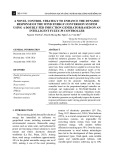


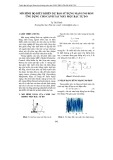


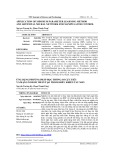

![Đề cương đề tài nghiên cứu khoa học [chuẩn nhất/mới nhất]](https://cdn.tailieu.vn/images/document/thumbnail/2025/20251117/duong297/135x160/26111763433948.jpg)










